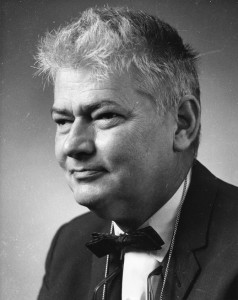Duncan Robert Stuart
contributed by Rachel McCall . Have you ever wondered how North Carolina State University became what it is today? We have plenty of faculty and students that changed the campus, one example is Duncan Robert Stuart.
Duncan Robert Stuart was a co-founder of the School of Design. He was a painter, designer, mathematician, and an associate professor of design. Stuart had paintings displayed at the Metropolitan Museum of Art, the Whitney Museum, and the Chicago Art Institute. He was also interested in mathematics, especially Geometry. He did work that supported the Geodesic Dome designed by Buckminster Fuller and did a lecture series at Harvard about how space could be divided.
One of his greatest achievements was teaching. He was known for his unconventional teaching style and the personal interest he took in his students. Stuart wanted his students to think for themselves. He would pose a question at the beginning of class and make students come up with solutions. His main goal was to teach students how to think even if they did not come up with an answer. He also believed that students should be graded on their degree of involvement rather than achievement. This way they could experiment with different subjects.
Although he passed away in 2001, Stuart's advice is still relevant to students and professors today. An article written by Jane Hall, in the News&Observer , has two of my favorite quotes from Stuart:
"Americans have an absolute horror of making mistakes. Yet in the long run, that's the only way we learn. When we get things right, we don't get much information. When we make mistakes we really begin to dig."
"Today we know that we are unable to anticipate the world the student is going to live in. Unless he learns to formulate his own problems he will find himself severely handicapped because the world demands that he do so."
For more information on important people from NCSU or the Design School visit us at: http://www.lib.ncsu.edu/specialcollections
For more photographs like the one above visit us at: https://historicalstate.lib.ncsu.edu/
